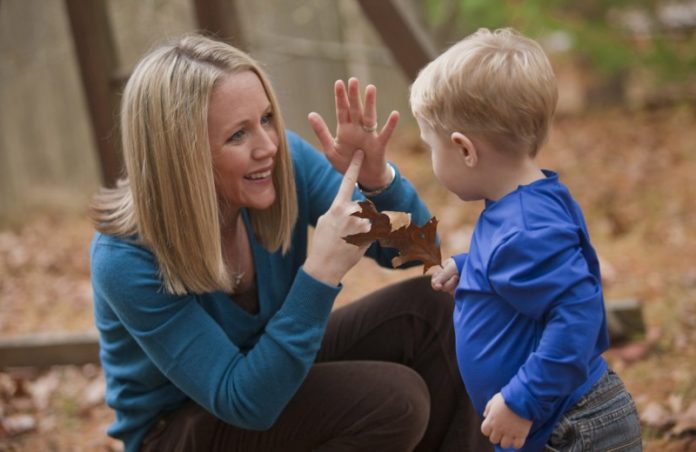Learning language comes naturally to babies; they are like sponges soaking up information that they receive from the environment around them. At very young ages they are already mimicking the faces and sounds that their parents and siblings make, and they begin to express their wants and needs through babbles, gestures and cries. In our melting pot of a country, more and more families are teaching their children multiple languages whether it is to preserve their native cultures, or to give their children the words to communicate with all people in their life (family, teachers, friends). Whatever the reason, with many children utilizing more than one language, some families worry that learning more than one language at a time could be confusing. Fortunately, according to the Multilingual Children’s Association, this claim has been proven false by decades of research and from reports from countless families around the world, including the many bilingual countries where multilingualism is the norm, instead of the exception. It is much easier for a baby/child to learn multiple languages than it would ever be for us to learn a second language as adults.
Sign language does not always come to mind when we talk about learning multiple languages, as we tend to think of spoken languages like English, French or Spanish. However, not only is American Sign Language a way that the deaf community communicates, it is a wonderful way to teach babies how to communicate with us before their verbal language comes. Sign language helps babies to express what they want, and gives them some control over conversation, and helps to decrease tantrums. Instead of guessing, parents know what their child is trying to tell them.
Begin teaching your baby sign language by associating a sign with a spoken word, and use the combination repetitively in order for them to get used to seeing it. The signs that are easiest to start with are ones that are typically used often and naturally throughout the day; mom, dad, eat, milk, more, finished and dog (or something else that baby is attached to, like another animal or toy). The child begins to learn that the signs correspond with the word they are using. It typically takes about two months, on average, for a child to begin using the signs back, although every child is different. Once your child begins using at least one sign back, then you can begin to introduce more.
Researchers and authors Linda Acredolo, PhD and Susan Goodwyn, PhD, the authors of Baby Signs: How to Talk with Your Baby Before Your Baby Can Talk (Contemporary Books, 2002), have found in their 20 years of research on the effects of Baby Signs on babies’ development, five reasons that parents should teach Sign Language to their hearing children:
1. Helps babies talk sooner and boosts spoken vocabulary – Acredolo and Goodwyn have found that Baby Signers actually talk sooner than non-signers. The reason being that they are using expressive language from an earlier age, playing with words, ideas and pairing them up before they have even developed the oral motor skills necessary for speech. In addition, they have found that by age eight, children who signed had stronger reading skills than those who did not.
2. Empowers babies to direct adults’ attention to what they want to talk about – Most babies will show signs of wanting to communicate by coming up with their own simple gestures, such as raising their arms to say “pick me up,” reach for things they want, pat the couch to say “up”, or open their mouth wide when they want more food. Signs expand on this idea and offer children an opportunity to communicate about specific ideas or concepts. It also gives them some control over the conversation; if they see something that they like, for example a train, they can sign it, beginning a conversation about something they are interested in.
3. Reduces frustration – Parents and researchers agree that after learning sign language as a communication tool, both child and parent have fewer moments of frustration that stem from a lack of communication. Tantrums decrease, and parents have found that they can discipline or redirect their child in public without using their voice, therefore avoiding embarrassing moments for the child. The most frustrating age for a toddler is 17-22 months because although he is mobile and understands what you’re saying, he may not be able to communicate about what he wants. Sign language can help clarify communication between parent and child, replacing frustration with clear expressions of thoughts. Children as young as six to eight months old can understand the signs for “milk,” “more,” and “all done.” Between eight and 12 months, children often begin signing “more” when they are out of Cheerios or would like another push on a swing, or they will sign “all done” when they have had enough to eat or want to leave the mall. Once children start speaking, parents have found that signs help fill in the gaps until the child is able to intelligibly communicate all the thoughts he wants to share.
4. Provides a strong foundation for early literacy – Signs make books more meaningful to babies. Your child can be an active participant in story time, labeling pictures and predicting what comes next in their favorite books. This kind of participation and interaction helps children understand the similarities and differences between concepts. When they first learn the sign for “dog,” they may generalize it and label all mammals in a book “dog.” Once the parent has helped them learn to see the distinguishing features of a dog, as well as other animals, they can then learn to generalize the sign for “dog” to the family pet, and a dog in one of their books.
5. Stimulate intellectual development – Participation in reading activities, along with the vocabulary boost inherent in early communication, lead to stronger early reading skills. Marilyn Daniels, author of Dancing With Words: Signing for Hearing Children’s Literacy (Bergin & Garvey, 2001), found in her research that hearing students in pre-kindergarten who had the benefit of adding the visual and kinesthetic (movement) elements of sign language to verbal and written language scored significantly higher on standardized vocabulary tests than hearing students with no sign instruction. Adding sign language to verbal communication has been found to help enhance a preschool child’s vocabulary, spelling and early reading skills.








